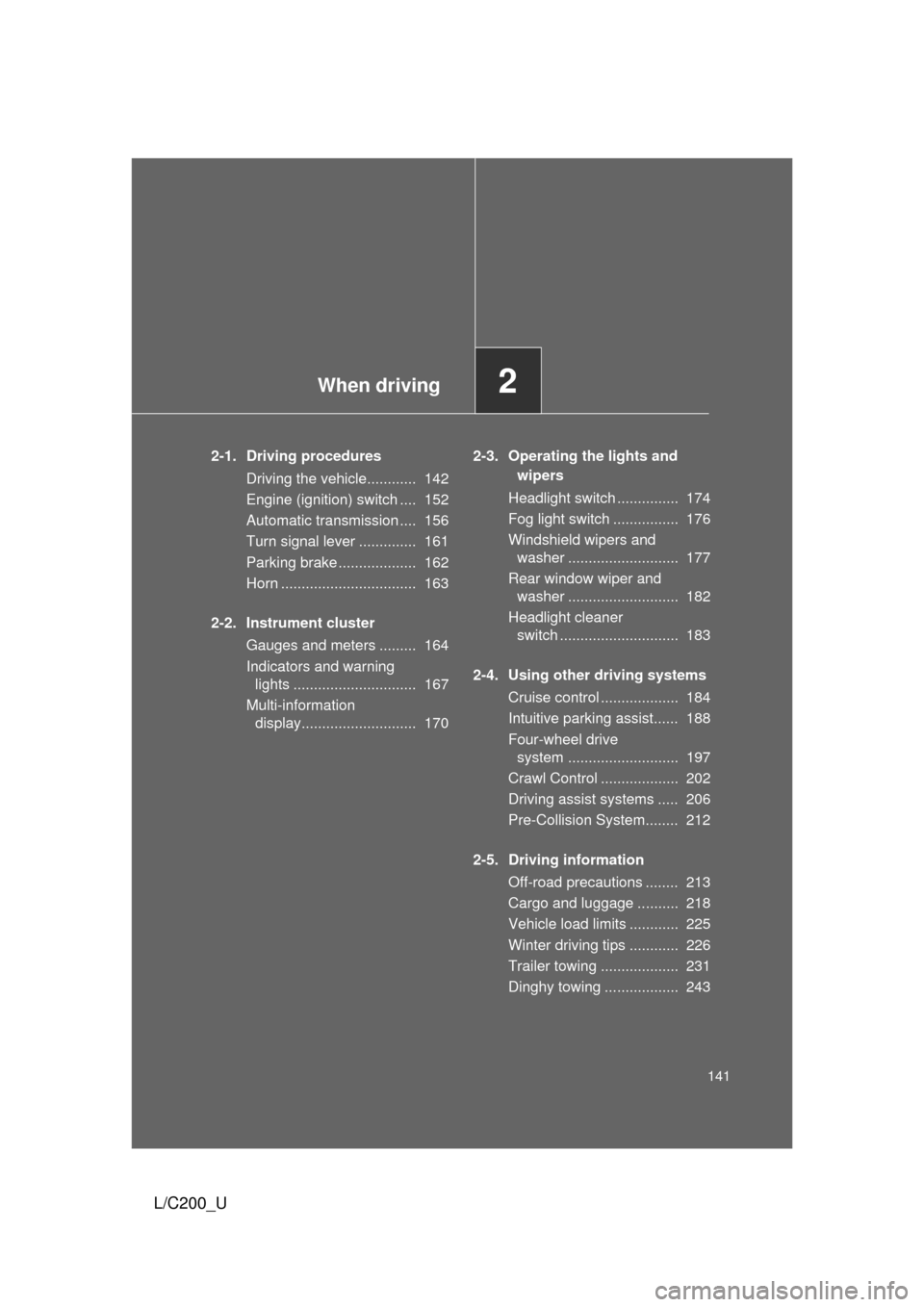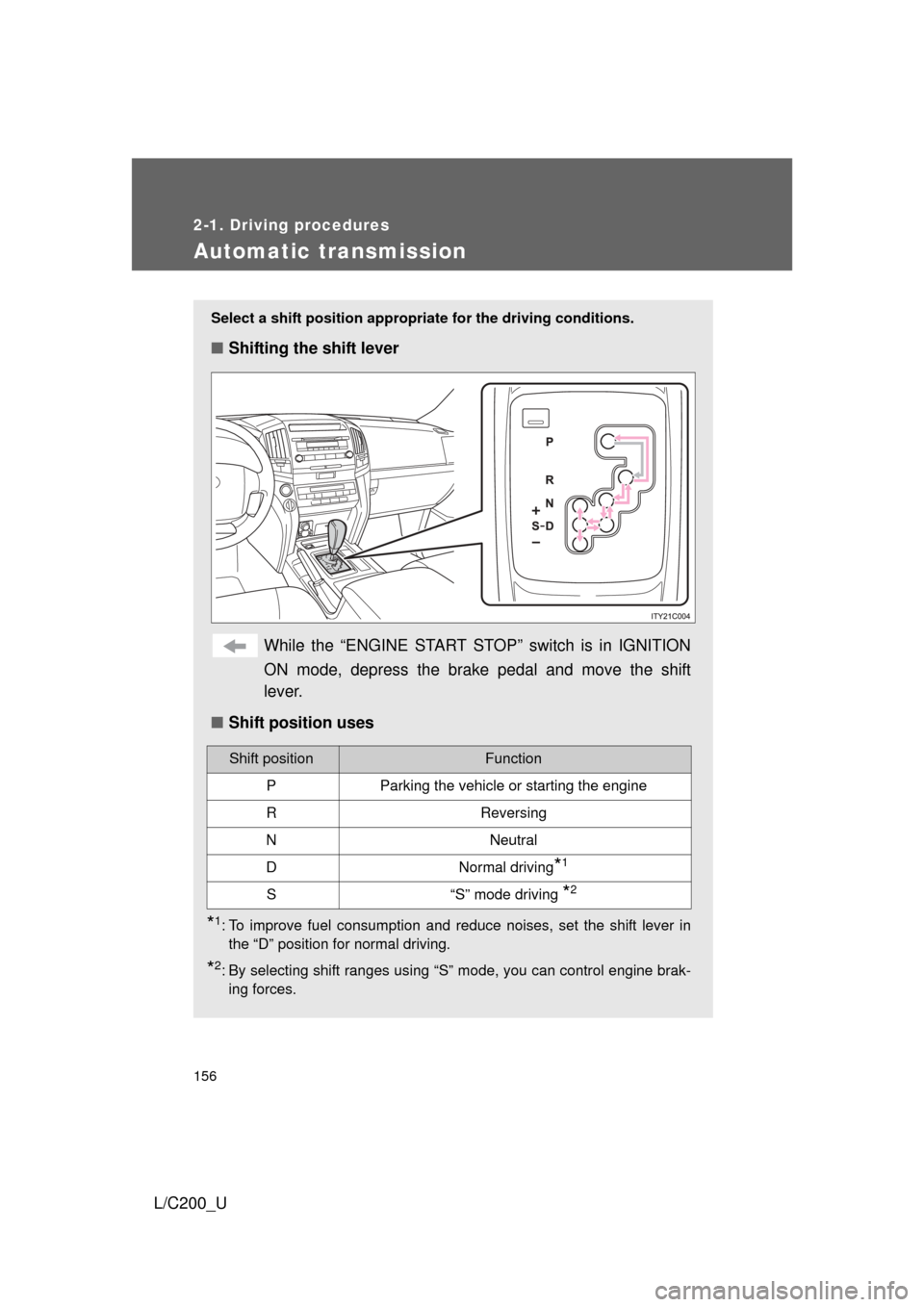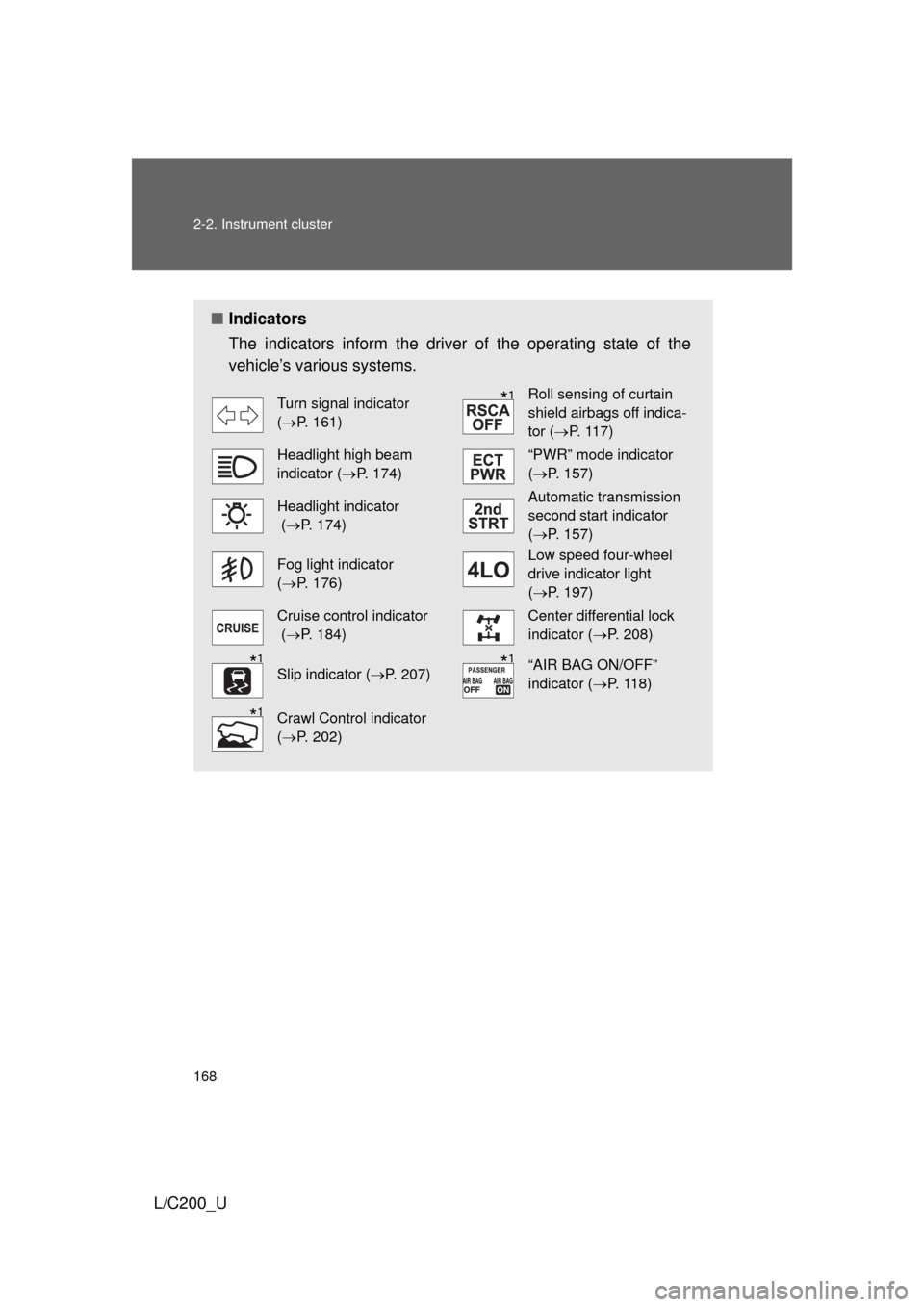2010 TOYOTA LAND CRUISER transmission
[x] Cancel search: transmissionPage 2 of 592

TABLE OF CONTENTSIndex
2
L/C200_U
1-1. Key informationKeys ..................................... 24
1-2. Opening, closing and locking the doors
Smart key system................. 26
Wireless remote control ....... 39
Side doors ............................ 42
Back door ............................. 47
1-3. Adjustable components (seats, mirrors,
steering wheel)
Front seats ........................... 52
Rear seats ............................ 54
Driving position memory system ................................ 63
Head restraints ..................... 67
Seat belts ............................. 71
Steering wheel ..................... 80
Inside rear view mirror.......... 82
Outside rear view mirrors ..... 83
1-4. Opening and closing the windows and moon roof
Power windows .................... 86
Moon roof ............................. 89
1-5. Refueling Opening the fuel tank cap .... 92 1-6. Theft deterrent system
Engine immobilizer system ................................ 96
Alarm .................................... 98
1-7. Safety information Correct driving posture ....... 101
SRS airbags ....................... 103
Front passenger occupant classification system ......... 118
Child restraint systems ....... 124
Installing child restraints ..... 128
2-1. Driving procedures Driving the vehicle .............. 142
Engine (ignition) switch....... 152
Automatic transmission ...... 156
Turn signal lever ................. 161
Parking brake ..................... 162
Horn .................................... 163
2-2. Instrument cluster Gauges and meters ............ 164
Indicators and warning lights ................................. 167
Multi-information display ..... 170
2-3. Operating the lights and wipers
Headlight switch ................. 174
Fog light switch ................... 176
1Before driving
2When driving
Page 141 of 592

When driving2
141
L/C200_U
2-1. Driving proceduresDriving the vehicle............ 142
Engine (ignition) switch .... 152
Automatic transmission .... 156
Turn signal lever .............. 161
Parking brake ................... 162
Horn ................................. 163
2-2. Instrument cluster Gauges and meters ......... 164
Indicators and warning lights .............................. 167
Multi-information display............................ 170 2-3. Operating the lights and
wipers
Headlight switch ............... 174
Fog light switch ................ 176
Windshield wipers and washer ........................... 177
Rear window wiper and washer ........................... 182
Headlight cleaner switch ............................. 183
2-4. Using other driving systems Cruise control ................... 184
Intuitive parking assist...... 188
Four-wheel drive system ........................... 197
Crawl Control ................... 202
Driving assist systems ..... 206
Pre-Collision System........ 212
2-5. Driving information Off-road precautions ........ 213
Cargo and luggage .......... 218
Vehicle load limits ............ 225
Winter driving tips ............ 226
Trailer towing ................... 231
Dinghy towing .................. 243
Page 144 of 592

144 2-1. Driving procedures
L/C200_U
CAUTION
■When starting the vehicle
Always keep your foot on the brake pedal while stopped with the engine run-
ning. This prevents the vehicle from creeping.
■ When driving the vehicle
● Do not drive if you are unfamiliar with the location of the brake and accel-
erator pedals to avoid depressing the wrong pedal.
• Accidentally depressing the accelerator pedal instead of the brake
pedal will result in sudden acceleration that may lead to an accident
that could result in death or serious injury.
• When backing up, you may twist your body around, leading to a diffi- culty in operating the pedals. Make sure to operate the pedals properly.
• Make sure to keep a correct driving posture even when moving the vehicle only slightly, allowing you to depress the brake and accelerator
pedals properly.
• Depress the brake pedal using your right foot. Depressing the brake pedal using your left foot may delay response in an emergency, result-
ing in an accident.
● Do not drive the vehicle over or st op the vehicle near flammable materials.
The exhaust system and exhaust gases can be extremely hot. This may
cause a fire if there is any flammable material nearby.
● Do not let the vehicle roll backwards while the shift lever is in a driving
position, or roll forward while the shift lever is in “R”.
Doing so may cause the engine to stall and lead to poor steering perfor-
mance, resulting in an accident or damage to the vehicle.
● If the smell of exhaust is noticed inside the vehicle, open the windows and
check that the back door is closed. Large amounts of exhaust in the vehi-
cle can cause driver drowsiness and an accident, resulting in death or a
serious health hazard. Have the vehicle inspected by your Toyota dealer
immediately.
● Do not shift the shift lever to "P" while the vehicle is moving.
Doing so can damage the transmission and may result in a loss of vehicle\
control.
Page 145 of 592

145
2-1. Driving procedures
2
When driving
L/C200_U
CAUTION
●
Do not shift the shift lever to "R" while the vehicle is moving forward.
Doing so can damage the transmission and may result in a loss of vehicle\
control.
● Do not shift the shift lever to "D" while the vehicle is moving backward.
Doing so can damage the transmission and may result in a loss of vehicle\
control.
● Moving the shift lever to "N" while the vehicle is moving will disengage the
engine from the transmission. Engine braking is not available when "N" is
selected.
● During normal driving, do not turn off the engine. Turning the engine off
while driving will not cause loss of steering or braking control, but the
power assist to these systems will be lost. This will make it more difficult to
steer and brake, so you should pull over and stop the vehicle as soon as it
is safe to do so.
However, in the event of an emergency, such as if it becomes impossible
to stop the vehicle in the normal way: P. 500
● Use engine braking (downshift) to maintain a safe speed when driving
down a steep hill.
Using the brakes continuously may cause the brakes to overheat and lose
effectiveness. ( P. 156)
● When stopped on an inclined surface, use the brake pedal and parking
brake to prevent the vehicle from rolling backward or forward and causing
an accident.
● Do not adjust the position of the steering wheel, the seat, or the inside or
outside rear view mirrors while driving.
Doing so may result in a loss of vehicle control that can cause accidents
that may result in death or serious injury.
● Always check that all passengers’ arms, heads or other parts of their bod-
ies are not outside the vehicle, as this may result in death or serious injury.
● Do not drive in excess of the speed limit. Even if the legal speed limit per-
mits it, do not drive over 85 mph (140 km/h) unless your vehicle has high-
speed capability tires. Driving over 85 mph (140 km/h) may result in tire
failure, loss of control and possible injury. Be sure to consult a tire dealer
to determine whether the tires on your vehicle are high-speed capability
tires or not before driving at such speeds.
Page 147 of 592

147
2-1. Driving procedures
2
When driving
L/C200_U
CAUTION
■
When the vehicle is parked
● Do not leave glasses, cigarette lighters, spray cans, or soft drink cans in
the vehicle when it is in the sun.
Failure to do so may result in the following:
• Gas may leak from a cigarette lighter or spray can, and may lead to a
fire.
• The temperature inside the vehicle may cause the plastic lenses and plastic material of eye glasses to deform or crack.
• Soft drink cans may fracture, causing the contents to spray over the interior of the vehicle, and may also cause a short circuit in the vehi-
cle’s electrical components.
● Always apply the parking brake, shift the shift lever to “P”, stop the engine
and lock the vehicle.
Do not leave the vehicle unattended while the engine is running.
● If the shift lever is moved before the low speed four-wheel drive indicator
turns on/off, the transfer mode may not be shifted completely. The transfer
mode disengages both the front and rear driveshafts from the powertrain
and allows the vehicle to move regardless of the shift position. (At this
time, the indicator blinks and the buzzer sounds.)
Therefore, the vehicle is free to roll even if the automatic transmission is in
“P”. You or someone else could be seriously injured. You must complete
the shifting of the transfer mode. ( P. 197)
● Do not touch the exhaust pipe while the engine is running or immediately
after turning the engine off.
Doing so may cause burns.
● Do not leave the engine running in an area with snow build-up, or where it
is snowing. If snowbanks build up around the vehicle while the engine is
running, exhaust gases may collect and enter the vehicle. This may lead
to death or a serious health hazard.
Page 156 of 592

156
2-1. Driving procedures
L/C200_U
Automatic transmission
Select a shift position appropriate for the driving conditions.
■Shifting the shift lever
While the “ENGINE START STOP” switch is in IGNITION
ON mode, depress the brake pedal and move the shift
lever.
■ Shift position uses
*1: To improve fuel consumption and reduce noises, set the shift lever in
the “D” position for normal driving.
*2: By selecting shift ranges using “S” mode, you can control engine brak-ing forces.
Shift positionFunction
PParking the vehicle or starting the engine
RReversing
NNeutral
DNormal driving*1
S“S” mode driving *2
Page 160 of 592

160 2-1. Driving procedures
L/C200_U
■“S” mode
When the shift range is “5” or lower, holding the shift lever toward “+” sets
the shift range to “6”.
■ Downshifting restrictions warning buzzer (in the “S” mode)
To help ensure safety and driving performance, downshifting operation may
sometimes be restricted. In some circumstances, downshifting may not be
possible even when the shift lever is operated. (The warning buzzer will
sound twice.)
■ When driving with the cruise control system
The engine brake will not operate in t he “S” mode, even when downshifting
to “5” or “4”. ( P. 184)
■ Second start mode au tomatic deactivation
Second start mode is automatically deactivated if the engine is turned off
after driving in second start mode.
■ If the shift lever cannot be shifted from “P”
P. 5 2 8
■If the “S” indicator does not come on even after shifting the shift lever
to “S”
This may indicate a malfunction in the automatic transmission system. Have
the vehicle inspected by your Toyota dealer immediately.
(In this situation, the vehicle will operate as if the shift lever is in “D”.)
■ AI-SHIFT
The AI-SHIFT automatically shifts the gear to the optimal position according
to the driver performance and driving conditions.
The AI-SHIFT automatically operates when the shift lever is in the “D” posi-
tion. (Shifting the shift lever to the “S” position cancels the function.)
Page 168 of 592

168 2-2. Instrument cluster
L/C200_U
■Indicators
The indicators inform the driver of the operating state of the
vehicle’s various systems.
Turn signal indicator
(P. 161)Roll sensing of curtain
shield airbags off indica-
tor ( P. 117)
Headlight high beam
indicator ( P. 174)“PWR” mode indicator
(P. 157)
Headlight indicator
( P. 174)Automatic transmission
second start indicator
(P. 157)
Fog light indicator
(P. 176) Low speed four-wheel
drive indicator light
(P. 197)
Cruise control indicator
( P. 184)Center differential lock
indicator ( P. 208)
Slip indicator ( P. 207)“AIR BAG ON/OFF”
indicator (P. 118)
Crawl Control indicator
(P. 202)
*1
*1*1
*1